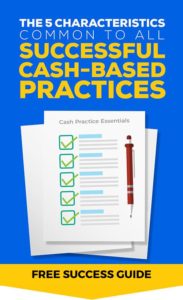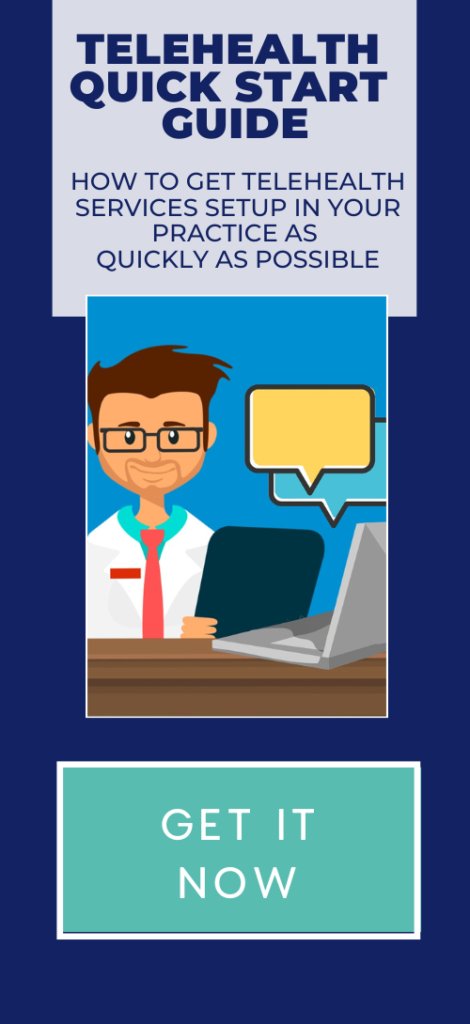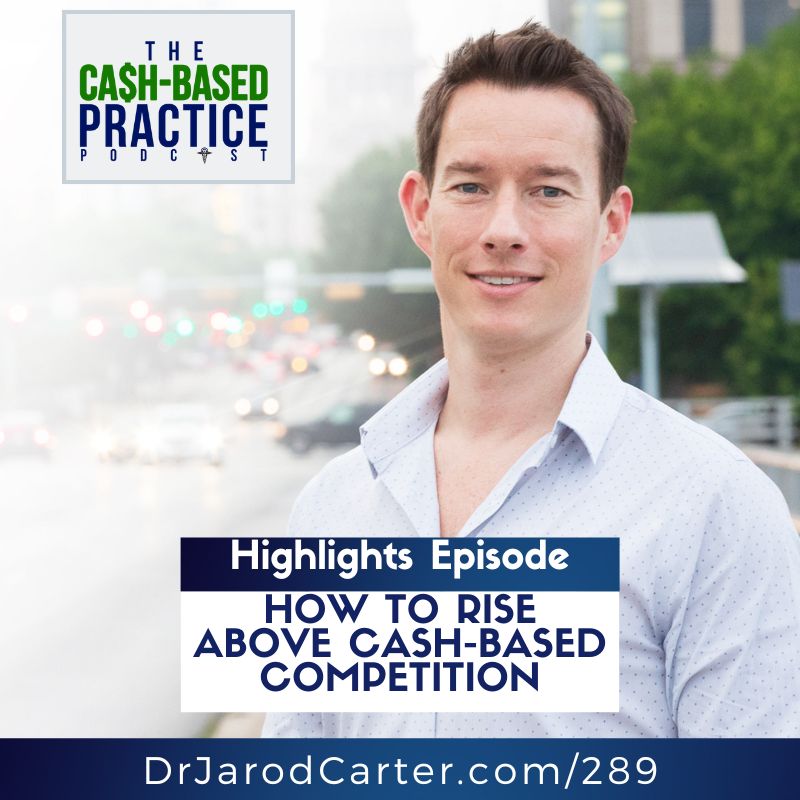Click here to download this episode
 In this episode, I interview Sara Squires Davis, a physical therapist who started her cash-based practice in Bethesda, Maryland about a year ago. I would link to her website, but at the time of this writing she has not yet created a website for her practice… she’s been too busy treating patients who pay her $250/eval and $175 for follow up treatment sessions! She has been immediately successful in the private pay business model and this interview is all about her story and how she has done so well.
In this episode, I interview Sara Squires Davis, a physical therapist who started her cash-based practice in Bethesda, Maryland about a year ago. I would link to her website, but at the time of this writing she has not yet created a website for her practice… she’s been too busy treating patients who pay her $250/eval and $175 for follow up treatment sessions! She has been immediately successful in the private pay business model and this interview is all about her story and how she has done so well.
More specifically, we talk about these cash-practice topics:
- What drove her to start her own practice and why she chose to be stay completely out-of-network with any 3rd Party Payors.
- How relationships with concierge Medical Practices have really helped her to be successful in this model.
- Logistical topics like the payment processor she uses (and why).
- A unique approach to how she performs and writes up her evaluations to help her professional image in the eyes of referring physicians.
- A scheduling tip that saves her time and allows her to predict her monthly revenue.
- The ways she kept her overhead low, but also the areas where she was willing to spend extra money during her first year.
Resources and Links mentioned in this episode:
- Merchant One – credit card payments
- Paypal Here – smartphone swipe system I use to take payments
Interested in the cash-based private practice model?
Click Here to learn how to start your own Cash-Based Practice
Let us know if you enjoyed the show:
[Click to Tweet] Great interview with Cash Practice owner Sara Squires Davis and @DrJarodCarter







Hi Dr. Carter,
I think you are doing a great thing with your show and blog. I have been a PT for 8 years now and private practice owner for 12 years and still wake up every day seeking out better ways to both treat my patients and operate my business. My clinic is a hybrid offering both insurance and direct pay services, but my approach is starkly different than you and your guest. I believe it is our responsibility as PT’s to provide the highest level of care and the absolute lowest possible price. I have been striving to reduce my cash pay rate to as little as $10 a visit without violating my existing payer contracts or state regulations. I wonder if any of your listeners/readers are doing the same? I would love to hear from them if they are.
Keep up the good work and thanks for sharing.
Hi Anthony,
Thanks for your comment and question. Hopefully others will see and reply.
I have to ask … how do you have such a low cash pay rate and stay profitable? Would love to learn from you and your approach to the hybrid business model.
I sent you a reply email with lots of detail regarding our $10 per visit “opportunity” but in case you didn’t get it, the basic idea is that it is a way for me offer services at or near Pro-Bono rates to patients that would never normally receive PT treatments and in so doing create a marketing opportunity for me to reach that patient’s immediate circle friends and family as well as provide physicians with the chance to send me a larger variety of referrals. I think of it as a lead capture page, but in real life!
Do you find that when you are charging so little per visit you attract patients who don’t highly value the treatment, cancel often, are not compliant with the HEP, etc?
And I have to ask what most others reading this are likely wondering… How in the world can only collecting $10/visit be profitable? How long are the visits? Is all the care being provided by a physical therapist?
In our PT brains we love PT so much we assume everyone will take advantage of such an amazing offer, right! But the ironic part is that I hardly have any patients on the $10 program. It was originally developed as a way to reduce the barriers to PT for patients with high out of pocket costs that wouldn’t otherwise even consider coming to PT. I realized long ago that if a patient has never been to PT or has gone to a high volume – low quality PT practice in the past, they would never pay $50 or more to receive that kind of care. And I don’t blame them. By bringing the cost down to this level I can expose more potential patients to the quality of services we can provide and hence create “raving fans” that spread the word throughout the community.
To answer your questions, all care is provided by a PT or an amazingly skilled PTA (Our clinics usually maintain a better than one to one PT/PTA ratio.) All treatments are active, direct care, functional exercise or manual treatments. We don’t own a hydroculator, we don’t use passive modalities, and you won’t see any supine straight leg raises here. Most of these treatments are 50 to 60-minutes in duration and packed full of activity.
Now the stipulation is that a person has to pay $30 a week and is able to schedule up to three treatments a week. I required this because I believe patients need consistent and repetitive treatments. My care is ineffective in most cases if a patient does one session then comes back in a month for another session. Also, my clinic operates an extremely fluid schedule meaning that I have developed systems so when I have a cancellation in the afternoon or the next day that won’t be filled by a full price treatment, my scheduler knows to call the $30 a week client and have them fill that opening. This allows me to fill gaps in the schedule without displacing higher value treatments. I estimate that if I can stay at 40 to 50 treatments per 40-hours of clinical work I will usually have between 5 to 10 open appointments/week either due to cancellations or just slower episodes. By efficiently filling those slots with these discounted sessions my costs basis does not go up, but I am able to increase internal referrals consistently. I am also able to avoid overworking my clinicians by sticking to max productivity of 50 treatments a week. My clinical staff usually averages much less than that over a 12 month period so no burnout here.
Bill Murphy at foreverjobless has a great article named EV: Millionaire’s Math in which he discusses a situation that on the surface appears to be a money losing proposition but in reality is profitable when done correctly. In my area I am competing with physician owned physical therapy clinics, hospital owned physical therapy clinics, and other private practice clinics with 20+ years of local history. I entered this market 7 years ago without any connections and built a very successful / profitable practice with two locations by learning how to leverage my clinical skills and unique service proposition to my advantage. We don’t employ aides, all care is based on treatment styles adapted from clinicians like Gary Gray, Gray Cook, Kelly Starrett and several highly respected manual therapists.
By blending traditional third party payer reimbursement with extremely low cost cash pay options I have been able to maintain market average collection rates per visit without excessive productivity standards, but most importantly expand the scope and reach of our service to patients that would never normally realize how beneficial and life changing a great PT treatment can be. I think high volume low quality care does more damage to our profession than any physician owned practice could ever do.
PS: It is important to remember too that free samples have been a great tool drug reps use to get MD in the habit of prescribing certain meds, so when I tell a local ortho that I can see all his ACL reconstructions for as little as $10 a session and he knows I truly operate the best quality practice in town, he is more than happy to send me all of his higher reimbursing insurance patients as well. It will always be positive EV to treat one $10 referral knowing that I will receive five more $100+ referrals because of it.
PPS: I never do free evaluations. I don’t like that concept and never promote it. I believe a good PT with worth a pound of gold, however if patients never give us the chance to treat them our skills are useless.
Hi Anthony, in response to your comment above …
I have to start by thanking you for taking the time to write such a detailed comment. I unfortunately don’t have enough time to get quite as detailed as you today 🙂
My gut reaction to these $10 cash pay visits is to go on and on about how I feel this devalues physical therapy in the eyes of those who receive and hear about this offer. I believe we as a profession do a terrible job of presenting physical therapy as “High Value.” BUT when I put my opinions about that to the side for a moment, I really do appreciate some of the things you stated, and the fact that you are most definitely thinking outside of the box.
Thanks for mentioning Billy and his website here. I’ve met him here in Austin and he seems like a great guy. My brother and I have a poker coaching website we will be launching in the next few weeks, and I’m ever impressed with what Billy has done as an entrepreneur in that realm and many others. I especially like that you are analyzing your business decisions with EV in mind. For those out there reading this who do not know what that means, EV stands for “expected value”… http://en.wikipedia.org/wiki/Expected_value … and here is the blog post Anthony referenced above: http://foreverjobless.com/ev-millionaires-math/
Again, I understand your reasoning behind doing the $10 visits though I don’t think I’ll ever be able to support the provision of physical therapy for such a small amount (even if business-wise it is a long-term positive EV play)… just a pride thing I guess.
As someone who’s had a lot of experience now in the cash based realm, I do want to give you one piece of advice… Given these $10 visits may produce a number of more high dollar referrals for you, this may not be a bad business decision for an insurance-based practice. However, if you, like many others that visit this site, are interested in moving away from the insurance-based model and becoming progressively more cash-based, you may be digging a hole which is very difficult to climb out of. Transitioning from an insurance-based practice to a cash-based practice is more difficult than starting a cash-based practice from scratch, because the majority of established and past patients in an insurance-based practice have the mindset that their physical therapy should never cost more than a $25 co-pay. Insurance-based practices wanting to convert to cash-based model find that they have to market to an entirely new segment of the population with a different mindset about what they’re willing to pay for great health care services. In your situation, not only are your insurance-based patients expecting low out-of-pocket costs for their care, but you are also training all of your cash-based patients to expect the same thing. And if your schedule was full of only patients paying $10 a visit, your business would obviously not survive… These cash paying patients are essentially means to generate more insurance-based clientele where your revenue is much greater. So my point is that although this approach may end up being a good thing for your insurance-based practice, you are going to find that it builds even more hurdles for any possible transition to a cash-based model.
Thank you again so much for taking the time to share your thoughts in such detail. If you’re ever in Austin, we should get together for a poker night and test our understanding of EV 🙂
Great info! When you send the letter with the evaluation do you send a single business card with each envelope? I think this a great idea and please share how this works with the MD’s.
Very nice interview – and a nice perspective unique to the Bethesda marketplace.
Hi Everyone – Thank you so much for all the wonderful feedback from the interview – and thank you especially to Jarod for the opportunity! I am happy yo answer any questions I can, please feel free to contact me directly via email at sarasquiresdavis@hotmail.com or via LinkedIn.
Best,
Sara
Thank YOU again Sara! We appreciate all the great info
Hi Jarod,
When you talk about cash based business model, are you referring to OON insurance (deductibles, co insurances, copays) or are you talking about cash for service up front or both?
Great website, great blogs, great podcast. Opening my OON practice in June 2015 and your information has helped me build my confidence and limited my mistakes thus far.
Thanks again,
Marcello